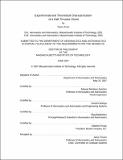Experimental and theoretical characterization of a Hall thruster plume
Author(s)
Azziz, Yassir, 1979-
DownloadFull printable version (4.636Mb)
Other Contributors
Massachusetts Institute of Technology. Dept. of Aeronautics and Astronautics.
Advisor
Manuel Martinez-Sanchez.
Terms of use
Metadata
Show full item recordAbstract
Despite the considerable flight heritage of the Hall thruster, the interaction of its plume with the spacecraft remains an important integration issue. Because in-flight data fully characterizing the plume in the space environment are currently unavailable, laboratory measurements are often used to understand plasma expansion and thereby minimize adverse plume-spacecraft interactions. However, experimental measurements obtained in ground facilities do not properly capture the wide angle plume effects most important for plume-spacecraft interactions because of the high background pressure of the laboratory environment. This research describes a method to determine the in-orbit plume divergence of a Hall thruster from laboratory measurements and characterizes the plasma properties of the in-orbit plume. Plume measurements were taken with a Faraday probe and a Retarding Potential Analyzer at various background pressures to correlate changes in current density and ion energy distribution with changes in pressure. Results showed that current density increases linearly with background pressure at any given angle. This linear relationship was used to extrapolate laboratory measurements to zero background pressure, the in-orbit condition. Measurements from the Faraday probe and the Retarding Potential Analyzer were compared to ensure consistency. The effect of discharge voltage on plume divergence was also investigated. Measurements from both probes revealed that plume divergence decreases with an increase in discharge voltage. Hall thruster plume expansion was also characterized using a numerical plume simulation. Comparison of plume simulation results for in-orbit conditions to extrapolated current density at zero pressure demonstrated good agreement. (cont.) However, comparison of plume simulation and experimental results at a non-zero background pressure showed deficiencies in the collision model of the plume simulation. An analytical expression for current density obtained using a elf-similar plume model was compared to extrapolated current density at zero pressure and showed good agreement. In addition, an analytical model derived for current density of source ion collisions with neutrals was consistent with experimental measurements and confirms the deficiencies in the simulation's collision model. In summary, experimental, numerical and analytical results indicate that the method of determining in-orbit plume divergence from laboratory measurements is valid and can be used to integrate Hall thrusters with the spacecraft.
Description
Thesis (Ph. D.)--Massachusetts Institute of Technology, Dept. of Aeronautics and Astronautics, 2007. This electronic version was submitted by the student author. The certified thesis is available in the Institute Archives and Special Collections. Page 230 blank. Includes bibliographical references (p. 201-206).
Date issued
2007Department
Massachusetts Institute of Technology. Department of Aeronautics and AstronauticsPublisher
Massachusetts Institute of Technology
Keywords
Aeronautics and Astronautics.